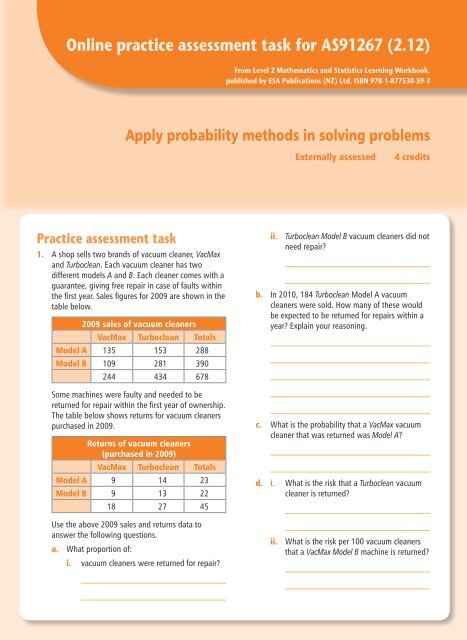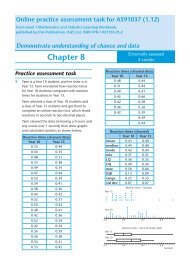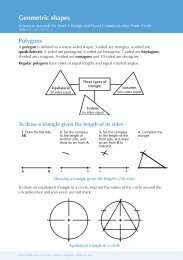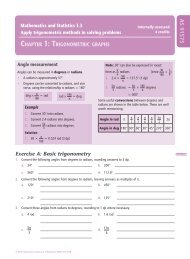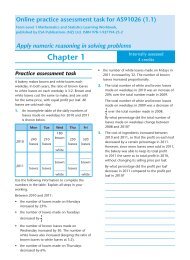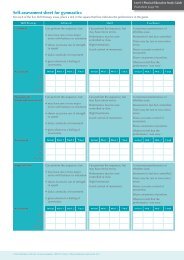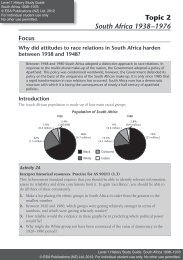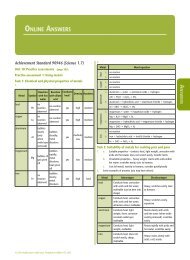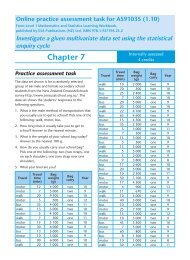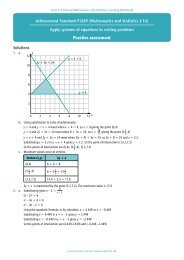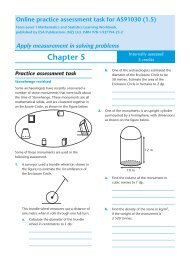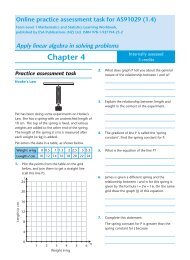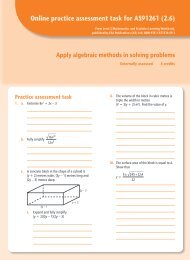Online practice assessment task for AS91267 ... - ESA Publications
Online practice assessment task for AS91267 ... - ESA Publications
Online practice assessment task for AS91267 ... - ESA Publications
You also want an ePaper? Increase the reach of your titles
YUMPU automatically turns print PDFs into web optimized ePapers that Google loves.
Apply probability methods in solving problems 1<br />
<strong>Online</strong> <strong>practice</strong> <strong>assessment</strong> <strong>task</strong> <strong>for</strong> <strong>AS91267</strong> (2.12)<br />
Practice <strong>assessment</strong> <strong>task</strong><br />
Apply probability methods in solving problems<br />
1. A shop sells two brands of vacuum cleaner, VacMax<br />
and Turboclean. Each vacuum cleaner has two<br />
different models A and B. Each cleaner comes with a<br />
guarantee, giving free repair in case of faults within<br />
the first year. Sales figures <strong>for</strong> 2009 are shown in the<br />
table below.<br />
2009 sales of vacuum cleaners<br />
VacMax Turboclean Totals<br />
Model A 135 153 288<br />
Model B 109 281 390<br />
244 434 678<br />
Some machines were faulty and needed to be<br />
returned <strong>for</strong> repair within the first year of ownership.<br />
The table below shows returns <strong>for</strong> vacuum cleaners<br />
purchased in 2009.<br />
Returns of vacuum cleaners<br />
(purchased in 2009)<br />
VacMax Turboclean Totals<br />
Model A 9 14 23<br />
Model B 9 13 22<br />
18 27 45<br />
Use the above 2009 sales and returns data to<br />
answer the following questions.<br />
a. What proportion of:<br />
i. vacuum cleaners were returned <strong>for</strong> repair?<br />
From Level 2 Mathematics and Statistics Learning Workbook,<br />
published by <strong>ESA</strong> <strong>Publications</strong> (NZ) Ltd, ISBN 978-1-877530-59-3<br />
Externally assessed 4 credits<br />
ii. Turboclean Model B vacuum cleaners did not<br />
need repair?<br />
b. In 2010, 184 Turboclean Model A vacuum<br />
cleaners were sold. How many of these would<br />
be expected to be returned <strong>for</strong> repairs within a<br />
year? Explain your reasoning.<br />
c. What is the probability that a VacMax vacuum<br />
cleaner that was returned was Model A?<br />
d. i. What is the risk that a Turboclean vacuum<br />
cleaner is returned?<br />
ii. What is the risk per 100 vacuum cleaners<br />
that a VacMax Model B machine is returned?<br />
© <strong>ESA</strong> <strong>Publications</strong> (NZ) Ltd, Freephone 0800-372 266
2 <strong>Online</strong> <strong>practice</strong> <strong>assessment</strong> <strong>task</strong> <strong>for</strong> <strong>AS91267</strong> (2.12)<br />
iii. What is the risk that a VacMax vacuum<br />
cleaner is returned?<br />
e. i. What is the relative risk of a Turboclean<br />
vacuum cleaner being returned, using the<br />
overall risk of a vacuum cleaner being<br />
repaired as the base line risk.<br />
ii. Explain in words what this means.<br />
f. A shop assistant claims that, <strong>for</strong> the VacMax<br />
brand of vacuum cleaner, both models are<br />
equally reliable, as the same numbers were<br />
returned <strong>for</strong> repairs. Comment on this claim,<br />
justifying your answer.<br />
2. At a swimming pool, 5 lanes are <strong>for</strong> the general<br />
public, and the 6th lane is used <strong>for</strong> swimming<br />
lessons. During the afternoon shift, the pool<br />
employs four staff members, Anne, Beth, Carl and<br />
Doug. At all times during the shift, one staff member<br />
supervises the public lanes and another staff<br />
member gives a swimming lesson. The remaining<br />
two staff members do other ‘non-lane’ <strong>task</strong>s such as<br />
administration, cleaning, ticketing etc.<br />
Lane duties are shared amongst the four staff<br />
members during the shift as follows.<br />
• For lessons: Anne takes 70%, with Beth and Carl<br />
taking the rest (all lessons are the same length).<br />
Beth takes the same number of lessons as Carl.<br />
<strong>ESA</strong> <strong>Publications</strong> (NZ) Ltd, Freephone 0800-372 266<br />
• For supervision of the public lanes: Doug<br />
spends half his shift, Carl spends 30% of his<br />
shift, Beth does half as much as Carl, and Anne<br />
does the rest.<br />
Some of this in<strong>for</strong>mation is shown on the probability<br />
tree below.<br />
5<br />
6<br />
Public<br />
Lesson<br />
Anne<br />
Beth<br />
Carl<br />
Doug<br />
Anne<br />
Beth<br />
Carl<br />
Doug<br />
a. What is the probability that at a randomly<br />
selected time during the afternoon shift:<br />
i. Beth is on duty on the lanes.<br />
ii. Carl is not on duty on the lanes?<br />
b. What is the probability that <strong>for</strong> a randomly<br />
selected lane during the shift:<br />
i. the lane is being used <strong>for</strong> a lesson?<br />
ii. the lane is public and Carl is supervising?<br />
iii. Anne is working there?<br />
c. What is the probability that a randomly selected<br />
lesson is being given by a female teacher?<br />
d. How much of his shift of 7 hours would Doug<br />
spend on ‘non-lane’ <strong>task</strong>s?
e. If there is ever an incident involving risk to the<br />
safety of a swimmer in the pool, a report must<br />
be filed by the person supervising or teaching<br />
in the lane. Of all reports filed during the<br />
afternoon shift, 7% involve an incident when<br />
Anne was supervising the public lanes and 12%<br />
involve an incident when Anne was taking a<br />
lesson.<br />
A report was filed by Anne during her shift.<br />
What is the probability it was about an incident<br />
in the lane used <strong>for</strong> swimming lessons?<br />
3. Jan travels to work each day by car. The times taken<br />
<strong>for</strong> her trips are normally distributed with a mean of<br />
15 minutes and a standard deviation of 4.5 minutes.<br />
a. What is the probability one of her trips takes<br />
less than 10 minutes?<br />
b. If Jan makes 150 of these trips then what is the<br />
expected number of times that her trip will take<br />
more than 17 minutes?<br />
Apply probability methods in solving problems 3<br />
c. If Jan arrives after 9.00 am then she is late <strong>for</strong><br />
work. If Jan leaves <strong>for</strong> work at 8.38 am then<br />
what is the probability she is late?<br />
d. What is the probability that one of Jan’s trips<br />
takes between 16 minutes and 18 minutes?<br />
e. What is the length of time that 70% of her trips<br />
to work are less than?<br />
© <strong>ESA</strong> <strong>Publications</strong> (NZ) Ltd, Freephone 0800-372 266
4 <strong>Online</strong> <strong>practice</strong> <strong>assessment</strong> <strong>task</strong> <strong>for</strong> <strong>AS91267</strong> (2.12)<br />
f. After a few years at her job, Jan thinks that it<br />
is taking her longer to get to work than it did<br />
when she first started. She keeps a record of<br />
how long it takes her to get to work <strong>for</strong><br />
3 months (64 trips) and finds that 4 of her trips<br />
took longer than 25 minutes. Do you think Jan<br />
is justified in her claim that her trips to work<br />
now take longer?<br />
<strong>ESA</strong> <strong>Publications</strong> (NZ) Ltd, Freephone 0800-372 266
Answers<br />
45<br />
1. a. i. or 0.066 (3 dp)<br />
678<br />
ii. 268<br />
or 0.954 (3 dp)<br />
281<br />
b. Assuming that the rate of<br />
returns in 2009 carries on<br />
into 2010, expect<br />
14<br />
× 184 = 16.8 to be<br />
153<br />
returned, i.e. 16 or 17<br />
Turboclean Model A vacuum<br />
cleaners.<br />
c. 0.5<br />
27<br />
d. i. or 0.062<br />
434<br />
ii. 8.3<br />
iii. 18<br />
or 0.074 (3 dp)<br />
244<br />
e. i. 0.939 (3 dp)<br />
ii. Turboclean vacuum<br />
cleaners are<br />
approximately 6% less<br />
likely to be returned<br />
than the average rate<br />
of returns of vacuum<br />
cleaners.<br />
f. The claim does not seem to<br />
be correct. For 2009 sales<br />
<strong>for</strong> VacMax, the relative risk<br />
of Model B being returned<br />
compared to Model A is<br />
9 9<br />
÷ = 1.24,<br />
109<br />
135<br />
so Model B is 24% more likely<br />
to be returned than Model A.<br />
2. a. i. 0.3 ii. 0.55<br />
b. i. 1<br />
6<br />
ii. 0.25<br />
iii. 19<br />
or 0.1583<br />
120<br />
c. 0.85 d. 3.5 hours<br />
e. 12<br />
or 0.6316<br />
19<br />
3. a. 0.1333 b. 49 or 50<br />
c. 0.0599 d. 0.1598<br />
e. 17.36 min<br />
Apply probability methods in solving problems 5<br />
f. Answers will vary.<br />
For a normally distributed<br />
variable with mean 15 min<br />
and standard deviation<br />
4.5 minutes, P(travel time ><br />
25 min) = 0.013. So <strong>for</strong> 64<br />
trips a travel time over<br />
25 minutes is expected to<br />
occur 0.013 × 64 = 0.8<br />
times, i.e. a maximum of<br />
1 trip would be expected to<br />
take over 25 minutes if these<br />
parameters are correct.<br />
Since a travel time over<br />
25 minutes occurred 4 times<br />
out of 64 trips (i.e. a relative<br />
frequency of 0.0625) <strong>for</strong><br />
Jan, a likely explanation<br />
is that the mean travel<br />
time has increased. Using<br />
inverse normal techniques,<br />
and assuming the standard<br />
deviation is unchanged,<br />
P(travel time > 25 min)<br />
= 0.0625 when the mean<br />
travel time is 18.1 minutes.<br />
If the standard deviation<br />
is unchanged, then Jan is<br />
justified in her claim that<br />
her trips to work now take<br />
longer.<br />
However, another<br />
explanation might be that<br />
the standard deviation has<br />
increased, and that there is<br />
more variability in the times<br />
Jan takes to travel to work.<br />
For example, if the mean is<br />
15 minutes but the standard<br />
deviation is 6.52 minutes,<br />
then P(travel time > 25 min)<br />
= 0.0625. The explanation<br />
may involve a change in both<br />
parameters, i.e. an increased<br />
mean travel time and an<br />
increased standard deviation.<br />
Alternatively, there may be<br />
sample variability caused by<br />
some temporary reason, e.g.<br />
road works, which meant<br />
increased travel times over<br />
the period of Jan’s survey.<br />
© <strong>ESA</strong> <strong>Publications</strong> (NZ) Ltd, Freephone 0800-372 266


